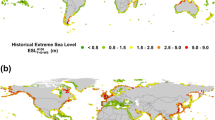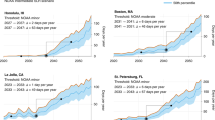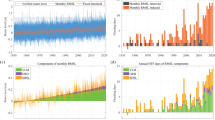Abstract
With dense population and development along its coastline, the northeastern United States is, at present, highly vulnerable to coastal flooding. At five sea level stations in the United States, from Massachusetts to New Jersey, sea level rise (SLR) trends and tidal effects were removed from the hourly sea level time series and then frequency analysis was performed on the positive remaining anomalies that represent storm surge heights. Then using eustatic SLR estimates for lower and higher greenhouse gas emissions scenarios and assumed trends in local sea level rise, new recurrence intervals were determined for future storm surges. Under the higher emissions scenario, by 2050, the elevation of the 2005 100-year event may be equaled or exceeded at least every 30 years at all sites. In more exposed US cities such as Boston, Massachusetts and Atlantic City, New Jersey, this could occur at the considerably higher frequency of every 8 years or less. Under the lower emissions scenario, by 2050, the elevation of the 2005 100-year event may be equaled or exceeded at least every 70 years at all sites. In Boston and Atlantic City, this could occur every 30 years or less.





Similar content being viewed by others
Notes
The Kirshen et al. analysis, which preceded the release of SLR projections by the IPCC AR4 Summary for Policy Makers, WG1 report (AR4), used projections of sea level rise due to thermal expansion based on simulations by a range of IPCC AR4 models, combined with estimates of SLR due to ice melt based on MAGICC simulations tuned to reproduce the SLR range provided in the IPCC Third Assessment Report (2001). The 12 cm value used in this analysis for the lower B1 scenario is less than the lower B1 value of 18 cm reported in AR4. The 86 cm value used here is greater than the higher A1 fi value of 59 cm reported in AR4, but less than the mid-range A1 fi value provided by Rahmstorf (2007) of 95 cm. An updated analysis of coastal flooding by Kirshen et al. uses the IPCC AR4 SLR projections. These results are presented in the synthesis report of the Northeast Climate Impacts Assessment. A description of the updated data and methods is available at: www.northeastclimateimpacts.org
References
Bindoff N, Willebrand J (2007) Chapter 5: Observations: oceanic climate change and sea level. In: Solomon S, Dahe Q, Manning M (eds) Climate change 2007: the physical science basis. Cambridge University Press, Cambridge, U.K
Chowdhury JU, Stedinger JR, Lu L-H (1991) Goodness-of-fit tests for regional generalized extreme value flood distributions. Water Resour Res 27(7):1765–1776
Church JA, Gregory JM (2001) Chapter 11: changes in sea level. In: Houghton JT et al. (eds) Climate change 2001: the scientific basis, third assessment report. Cambridge University Press, Cambridge, U.K., pp 639–694
Church JA, White NJ, Coleman R, Lambeck K, Mitrovica JX (2004) Estimates of the regional distribution of sea level rise over the 1950–2000 period. J Clim 17:2609–2625
Clark G, Moser S, Ratick S, Dow K, Meyer M, Emani S, Jin W, Kasperson J, Kasperson R, Schwarz H (1998) Assessing the vulnerability of coastal communities to extreme storms: the case of Revere, MA, USA. Mitig Adapt Strategies Glob Chang 3:59–82
Cooper M, Beevers M, Oppenheimer M (2005) Future sea level rise and the New Jersey Coast, assessing potential impacts and opportunities. Woodrow Wilson School of Public and International Affairs. Princeton University, Princeton, NJ
Douglas, EM, Vogel RM (2006) The behavior of the flood of record for basins in the U.S. J Hydrol Eng 11(5):482–488
Emanuel KA (2005) Increasing destructiveness of tropical cyclones over the past 30 fears. Nature 436:686–688
Flather R, Williams J (2000) Climate change effects on storm surges: methodologies and results, ECLAT-2 Report No 3. Climatic Research Unit, University of East Anglia, Norwich, UK
Flick R, Murray J, Ewing L (1999) Trends in United States tidal datum statistics and tide range, a data atlas report. Scripps Institute of Oceanography Reference Series Number 99–20, December, 1999
Gumbel EJ (1958) Statistics of extremes. Columbia University Press, New York
Holgate S J and Woodworth PL (2004) Evidence for enhanced coastal sea level rise during the 1990s. Geophys. Res. Ltrs, 31, L07305, DOI 10.1029/2004GL019626
Hosking JRM, Wallis JR (1997) Regional frequency analysis: an approach based on L-moments. Cambridge University Press, Cambridge, U.K
Kirshen P, Ruth M, Anderson W and Lakshmanan TR (2004) Infrastructure systems, services and climate change: integrated impacts and response strategies for the Boston metropolitan area. Final Report to US EPA ORD, EPA Grant Number: R.827450–01
Kirshen P, Ruth M, and Anderson W (2006) Climate’s long-term impacts on urban infrastructures and services: the case of Metro Boston, Chapter 7 of Ruth M, Donaghy K, and Kirshen PH, (eds.) Climate change and variability: local impacts and responses. Edward Elgar Publishers, Cheltenham, England
Nakicenovic N, Alcamo J, Davis G et al. (2000) IPCC Special report on emissions scenarios. Cambridge University Press, Cambridge, United Kingdom
New England Regional Assessment Group (2001) Preparing for a changing climate: the potential consequences of climate variability and change. New England Regional Overview, U.S. Global Change Research Program, University of New Hampshire, Durham NH, 96 pp
NOAA (2007) National Oceanic and Atmospheric Administration, Center for Operational Oceanographic Products and Services, Tides and Currents. http://tidesandcurrents.noaa.gov/. Cited 17 May 2007
Nucci Vine Associates, Inc. (1992) Potential effects of sea level rise in Boston Inner Harbor. Newburyport, Massachusetts, 36 pp
Pugh D (2004) Changing sea levels: effects of tides, weather and climate. Cambridge University Press, Cambridge, United Kingdom
Rahmstorf, S (2007). A semi-empirical approach to projecting future sea-level rise, Science, Vol 315, 19 January
Rosenzweig C, Solecki W (eds) (2001) Climate change and a global city: the potential consequences of climate variability and change—Metro East Coast. Report for the US National Assessment of the Potential Consequences of Climate Variability and Change, Columbia Earth Institute, New York
Stedinger, JR, Vogel RM, Foufoula-Georgiou E (1993) Frequency analysis of extreme events. In: DR Maidment (ed) Handbook of Hydrology. McGraw-Hill, Inc., New York, pp 18.1–18.66
Thompson EM, Baise LG, Vogel RM (2007) A global index earthquake approach to probabilistic assessment of extremes. J Geophys Res 112, B06314, DOI 10.1029/2006JB004543
US Army Corps of Engineers (1990) Flood damage reduction, main report, Saugus river and tributaries. New England Division, Concord, Massachusetts
US Department of Commerce (2000) Tide and current glossary. Silver Spring, Maryland
van den Brink HW, Konnen GP, Opsteegh JD (2003) The reliability of extreme surge levels estimated from observational records of order hundred years. J Coast Res 19(2):376–388
Wigley TML (1994) MAGICC (Model for the Assessment of Greenhouse-Gas Induced Climate Change): user’s manual and scientific reference manual. National Center for Atmospheric Research, Boulder, Colorado
Zhang K, Douglas B, Leatherman SP (2000) Twentieth-century storm activity along the U.S. East Coast. J Climate 13:1748–1761
Acknowledgements
The authors appreciate the support of the other participants in the Northeast Climate Impacts Assessment (NECIA) sponsored by the Union of Concerned Scientists. We are particularly grateful to Katharine Hayhoe for providing the SLR scenarios and the NECIA Synthesis Team and the article reviewers for their comments. Richard Vogel provided useful statistical insights. We are also grateful to Elisabeth Militz and Rita Koros who acquired the sea level data. Cameron Wake and Susi Moser provided leadership in assembling this article.
Author information
Authors and Affiliations
Corresponding author
Appendix A: GEV frequency analysis
Appendix A: GEV frequency analysis
For large samples, the cumulative distribution function for the maximum values of many probability distributions converges to one of three extreme value distributions (EV type I, II, or III) described by Gumbel (1958). The Generalized Extreme Value (GEV) distribution is a general mathematical form which incorporates Gumbel’s type I, II and III distributions for maxima (Stedinger et al. 1993). The parameters of the GEV distribution are ξ (location parameter), α (scale parameter) and κ (shape parameter). The Gumbel (EV type I) is obtained when κ = 0. For κ > 0, the distribution has a finite upper bound at \({\xi + \alpha } \mathord{\left/ {\vphantom {{\xi + \alpha } \kappa }} \right. \kern-\nulldelimiterspace} \kappa \) and corresponds to the EV type III distribution for maxima that are bounded from above. For this study, GEV parameters were estimated using the method of L-moments (Stedinger et al. 1993; Hosking and Wallis, 1997) and are shown in Table 6. GEV goodness-of-fit was confirmed using a probability plot correlation coefficient (PPCC) hypothesis test (Chowdhury et al. 1991) and an L-moment diagram. The PPCC hypothesis test indicated that the GEV adequately fit the annual maximum time series for all sites except Boston. However, the L-moment diagram indicated that the GEV could reproduce the moments of the detrended Boston data. In addition, a visual inspection of PPCC plots (Fig. 6) showed that the GEV fit the upper tail of the Boston time series reasonably well after the largest (1991) data point was removed; hence the GEV was deemed appropriate for all sites. For the Atlantic City and Boston sites, parameters were estimated both with and without trend removal.
Using the parameters estimates in Table 6, GEV quantile estimates, x p , for specified cumulative probabilities, p, were computed from
Cumulative probabilities (p) were converted to exceedance probabilities, pe = 1 − p. The return periods shown in Table 3 are 1/pe.
Rights and permissions
About this article
Cite this article
Kirshen, P., Watson, C., Douglas, E. et al. Coastal flooding in the Northeastern United States due to climate change. Mitig Adapt Strateg Glob Change 13, 437–451 (2008). https://doi.org/10.1007/s11027-007-9130-5
Received:
Revised:
Accepted:
Published:
Issue Date:
DOI: https://doi.org/10.1007/s11027-007-9130-5





